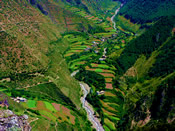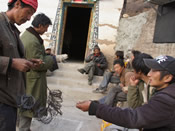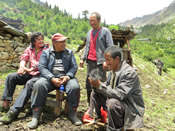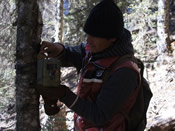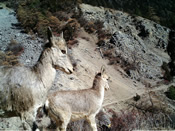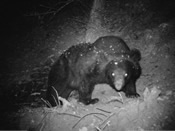By Mu Suo (PCD’s partner for the Deqin Programmes in Yunnan)
|
Editor's note: Jiangpo Village in Deqin County of Yunnan Province in China is a Tibetan community. In response to changes brought by modernisation, the community has recently revived various traditional customs to protect wildlife in the mountains. A new idea came up in the process—to let villagers observe wild animals using infrared cameras in order to realise the important goal of changing the way they feel about their wildlife. By capturing lovely images of wild animals, villagers experience the sense of harmonious coexistence between human beings and animals, and are motivated at a deep level to protect nature. Together with traditional religious inspiration, this strengthens the care and love of wild animals among different social groups in the local community. |

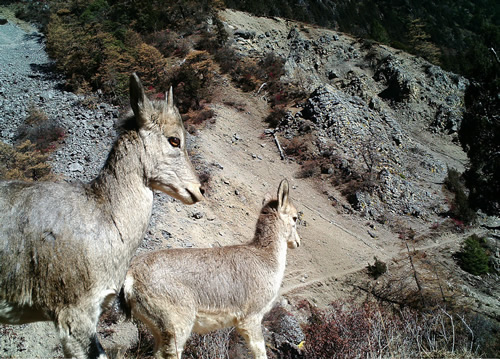 |
| A photograph of a beautiful bharal taken by an infrared camera in daylight. |
Introduction
Jiangpo is a village located on the eastern shore of Lancang River. Surrounded by lofty mountains, the village is situated facing the sacred Kawagarbo Peak in a hot, arid valley. Vegetation is scarce on the lower slopes of the mountains, but on the upper slopes there are dense primitive forests; and high altitude pastures are found on mountain tops where one can see snow-capped peaks all year round. The seven production brigades of Jiangpo Village are scattered in the zone where the forests and the barren slopes meet.
According to local tales, in Jiangpo there was a mountain god who possessed great magical power. Since he had a fiery temperament, both villagers and passers-by were afraid of him and treated him with extreme caution. There were many wild animals in the forest on the mountains surrounding Jiangpo but people rarely went hunting because they feared the fierce mountain god.
Jiangpo Village is a very traditional Tibetan village but its fate is closely associated with the conditions and development of the wider social environment. As society undergoes new development, the local traditional culture of the village is also experiencing changes. People are no longer afraid of the mountain god, and poaching has increased. In 2006, a programme to revive traditional customs was launched, led by Jiangpo villagers with the support of PCD. Wildlife protection is part of the programme. Apart from organising educational activities on traditional culture and customs and reviving local religious activities, a patrolling system was established for nature conservation. To protect wild animals, villagers (including not only herders but also youngsters and the elderly) occasionally patrol the mountains, removing wire snares used to trap animals and also garbage that people have left on the mountains. Over the years, thousands of wire snares have been collected and the wild animal populations are now showing signs of recovery. Villagers now appear to appreciate the harmonious coexistence between themselves and animals.
The focus of the programme has now shifted from protecting wildlife to encouraging villagers to participate in monitoring animals. Apart from male villagers of all ages and herders, lay Buddhists and health workers have also joined in the activity. In this new collaboration, simple mountain villagers have been using a hi-tech device which even the Office of National Nature Reserve at Deqin does not have—infrared cameras. Villagers are able to share the fruits of their efforts at home, watching images of their 'neighbours' whom they otherwise hardly have a chance to meet. As they look at the lovely images, the excited villagers also tell each other interesting stories about the wild animals.
Embarrassment of the lay Buddhists
In Jiangpo Village, lay Buddhists are the people most welcome and most respected by the villagers. They are Buddhist disciples who practice at home and who assume responsibilities similar to those of priests or clergy. The Jiangpo programme was led mainly by these lay Buddhists who are obviously the most advanced in terms of education, culture, personality and social status. However, they were the ones most embarrassed by their performance in using the infrared cameras.
At the end of the infrared camera training, participants were divided into five groups to go into the mountains to install hidden infrared cameras, in secret locations known only to the installers. Gesang, a lay Buddhist, said: "When I went into the mountains, I thought: I read Buddhist teachings all day long, how would I know where the animals could be seen? As a respected lay Buddhist, I felt embarrassed to ask other people. However, I could not bring an assistant with me either because the location of the camera could not be disclosed to another person.
"I wandered into the forest without knowing where to go. I saw a heap of animal manure and thought it was where they would come and go, so I installed the camera on a nearby tree. I came back for the camera 15 days later and looked at the shots on Sinanima's computer. Only a pheasant was seen once. It has now become a joke for everyone."
The experience of Anwu, another lay Buddhist, was slightly better. He knew he would not know where to install the camera in the forest, so he thought of another way. He installed the camera near a field next to the village—definitely some animals would wander into the village to look for food! In the end his camera captured some pheasants and small animals, and Anwu had done his job.
Veteran hunters demonstrating their talents
A few veteran hunters were invited to take part in the training. The purpose was rather obvious and everyone was well aware of it, but no one mentioned it openly. Sinacili, one of the hunters, took his camera to a small pond in the dense forest. It is a pond that animals like to go. He installed the camera on the branches of a tree next to the pond and managed to photograph many big animals, such as black bears, river deer and wild boar. The camera captured a range of animal behaviour including fighting, playing, drinking and sleeping.
Zhongtai is another experienced hunter. He advised that even though animals live in the dense forest they do like to walk on 'roads' just as human beings do, habitually following the same routes. At the same time, some animals cohabit while others are strongly territorial. Because of this, where one installs the camera depends on what animals one wants to capture. Zhongtai claimed that no matter what animals the programme team wanted to shoot, he would be able to capture them with his camera. Of course, the photos he obtained were greatly admired.
Perplexities of a doctor
Zhaxijiangchu, the doctor of Yagong Village, used to feel perplexed. Villagers of Yagong had moved into the mountains following a natural disaster. The farming land allotted to the doctor is located at the edge of the forest, and his crops have been devoured by unwanted guests from next door, such as monkeys and black bears. Even though he kept raising the height of his fence, he failed to stop his monkey brothers who were good gymnasts. After he got the infrared camera, he determined to capture the thieves in his fields with it. He went directly to his own field with the camera and installed it in the bushes at the edge.
Fifteen days later, full of expectations, the doctor brought the camera to Sinanima to read the data in the camera on his computer. The camera had taken so many photos that the memory card was completely full. Sinanima was surprised. "How could the camera have taken so many photos?" he asked.
"There are too many guests who have visited my fields! Come, hurry up, let's see who has been there…" replied the doctor.
The photos appeared on the screen one after another, but the result was disappointing. There were only flowers and grasses in the sun. Not one animal had been captured; not even small butterflies. It was a result that was difficult to understand and led to a heated discussion. In the end everyone decided to go to the site to have a look. They discovered that the doctor's field was located next to a deep valley facing east. He had installed the camera in a sunny spot among grasses and bushes. The deep valley was very windy as well. The infrared camera was sensitive to the warmth of the sun and the movement of the flowers and grasses in the wind. Whenever a warm flower or a blade of grass moved, the camera blindly took a photo, filling up the memory card with empty images on the very first morning.
Transformation of the poachers
When the herders Zhaxi and Sinacili went into the mountains to install their camera, they heard dogs barking from behind a hill. They waited quietly on the hilltop. Soon a few bharals ran towards them and made a circle around a hunting dog. They then ran away among the rocks opposite the herders. The dog tried to followed their footprints, but became confused and lost the trail. Soon two herders/poachers from outside the village arrived and asked Zhaxi and Sinacili if they had seen the bharals. "No, we didn't," answered Zhaxi and Sinaceli, "but how dare you hunt stealthily?"
"What is there to be afraid of?" answered the men. "No one sees us here deep in the mountains, and even if someone did see us, they wouldn't have the evidence to sue us!"
Sinacili took out the infrared camera from his bag and told them how the camera worked. "We were once expert hunters too, but the animals have parents and children. They have feelings. They are afraid of death and want to be free and happy. That's why I have sworn to our Master (a Buddhist teacher) that I would observe the precept against hunting. To compensate for the sins I have committed because of my hunting activities and to accumulate good deeds for my future life, now I work as a herder and I take part in patrolling the mountains to protect wildlife. I won't report you this time because we are neighbours and friends, but I don't want to see you doing this again," said Zaxi. Since then, no more hunters have appeared on this mountain.


